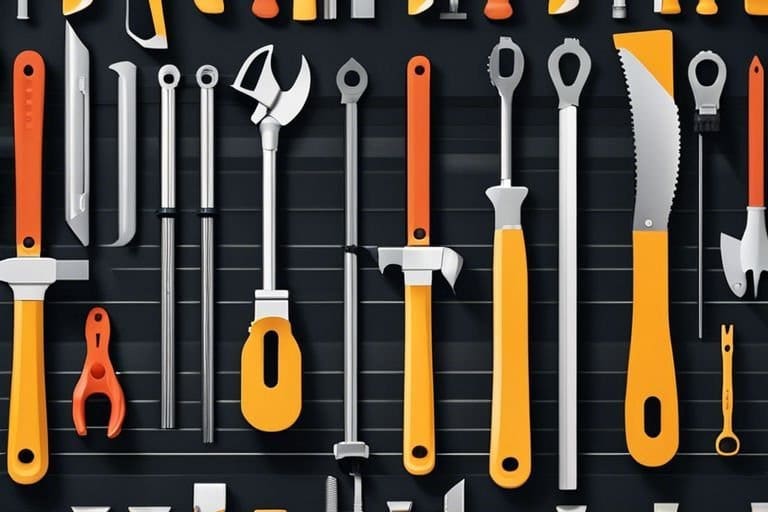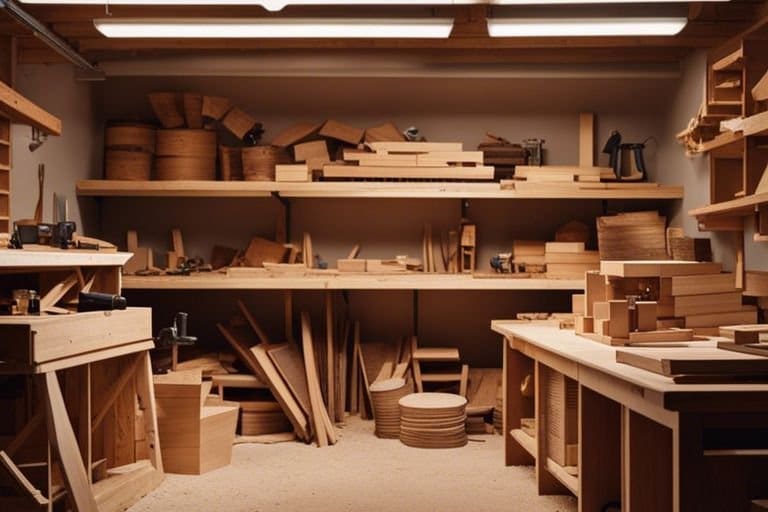Tool aficionados, are you using the right saw for your projects? In the woodworking realm, having the correct tool can make all the difference between a smoothly cut piece and a rough disaster. Join us as we research into the diverse world of saw varieties, from coping saws to Japanese pull saws, and discover which one suits your next masterpiece best. Let’s get sawing!
The World of Saws
Hand Saws: The Original Multitaskers
With roots dating back centuries, hand saws have been the trusty companions of woodworkers, carpenters, and DIY enthusiasts alike. These versatile tools come in a variety of shapes and sizes, each designed for specific tasks. From the classic crosscut saw to the rip saw and the dovetail saw, hand saws are the original multitaskers of the woodworking world.
Whether you’re cutting delicate joinery or making rough cuts, hand saws offer precision and control that power tools sometimes struggle to match. So, the next time you reach for a saw, consider the humble hand saw and embrace the satisfaction of traditional craftsmanship.
Power Saws: Speed Demons of the Workshop
Hand in hand with technological advances, power saws have revolutionized woodworking by offering speed and efficiency. From the circular saw to the jigsaw and the miter saw, these tools are the speed demons of the workshop, allowing for quick and accurate cuts with minimal effort.
In today’s fast-paced world, power saws have become indispensable for large-scale projects and professional woodworkers. Their ability to tackle tough materials with ease and precision makes them a must-have for anyone serious about their craft.
Workshop: While power saws are incredibly efficient, they also require caution and proper maintenance to ensure safe operation. Always follow safety guidelines and regularly check and maintain your power saws to keep them in top condition for years to come.
Cutting Through the Confusion
Little did you know, dear reader, that choosing the right saw for the job can make all the difference in the world. With a plethora of saw varieties available, it’s easy to get overwhelmed and make the wrong selection. Fear not, for we are here to guide you through the sawdust and confusion to help you wield the right tool for your woodworking needs.
Rip Cuts vs. Cross-Cuts: Know the Difference
To the untrained eye, all cuts may look the same, but in the woodworking world, there is a distinct disparity between rip cuts and cross-cuts. A rip cut is made along the length of the wood grain, ideal for cutting boards to width. On the other hand, a cross-cut is made across the wood grain, perfect for trimming boards to length. Understanding this disparity is crucial in selecting the appropriate saw for the task at hand.
Choosing the Right Saw for the Job
For those new to the woodworking realm, selecting the right saw can be akin to choosing the perfect whiskey – each has its unique characteristics and best serves a particular purpose. When initiateing on a project, consider the type of cuts you need to make, the size of the material you are working with, and your skill level. Whether it’s a circular saw for quick and rough cuts or a miter saw for precise angle cuts, each saw has its strengths that can make your woodworking endeavors smoother and more enjoyable.
Crosscuts, this knowledge will empower you to make informed decisions when it comes to selecting the appropriate saw for your projects, ensuring that you achieve the desired results with finesse and craftsmanship.
Specialized Saws for Specific Tasks
Coping Saws: Curves Ahead
If you find yourself needing to make intricate curved cuts in wood, a coping saw is the tool for you. This slender-bladed saw is designed to navigate tight curves and complex patterns with ease. It’s perfect for tasks like cutting out intricate designs, making internal cutouts, or fitting molding to irregular shapes. Any woodworking enthusiast will appreciate the precision and versatility that a coping saw brings to the workshop.
Jigsaws: The Wavy Line Wizards
Wizards of the woodworking world, jigsaws are the go-to tool for cutting wavy lines, curves, and irregular shapes. These handheld power tools feature a fine blade that moves up and down rapidly, allowing for intricate cuts in various materials such as wood, metal, and plastic. Whether you’re crafting a unique piece of furniture or tackling a DIY home improvement project, a jigsaw will become your best friend when it comes to creating smooth and precise curves.
Specific to jigsaws is their ability to not only cut curves but also tackle plunge cuts, bevel cuts, and straight cuts with ease. Their versatility makes them a must-have tool for any woodworker looking to add a touch of creativity to their projects.
Reciprocating Saws: Demolition Experts
In terms of demolition tasks, a reciprocating saw is the tool you need in your arsenal. These powerful saws feature a push-and-pull motion that allows them to cut through a wide range of materials, including wood, metal, and even masonry. Whether you’re dismantling old structures, cutting through pipes, or clearing out overgrown vegetation, a reciprocating saw is the ultimate demolition expert.
Tasks that would be time-consuming and challenging with traditional saws are made quick and easy with a reciprocating saw. Their ability to cut through almost anything makes them a valuable tool for both professional contractors and DIY enthusiasts alike.
Saws for Specific Materials
Tile Saws: Cutting Through the Hard Stuff
To tackle tough materials like ceramic, porcelain, and stone tiles, you need a specialized tool like a tile saw. These saws are designed to make precise cuts through hard materials without causing damage or leaving rough edges. With their diamond-encrusted blades and water-cooling system, tile saws ensure that your tiles are cut cleanly and accurately.
Metal-Cutting Saws: Tough Guys of the Workshop
Guys, when it comes to cutting metal, you can’t mess around with just any saw. Metal-cutting saws are the tough guys in the workshop, capable of slicing through steel, aluminum, and other metals with ease. These saws come in various types, such as band saws, chop saws, and circular saws, each tailored to specific metal-cutting needs.
Specifically, band saws are ideal for intricate cuts and curved shapes, while chop saws excel at making straight and angled cuts. Circular saws, on the other hand, offer versatility for various metal-cutting applications. Choose the right tool based on the thickness and type of metal you’re working with to ensure precise and efficient cuts.
Pruning Saws: Branching Out
With their specialized design for cutting through tree branches and shrubs, pruning saws are a must-have for any outdoor enthusiast or gardener. These saws feature sharp teeth and a rugged build that make quick work of woody stems and branches, helping you maintain your garden with ease. Whether you’re trimming overgrown bushes or pruning fruit trees, a pruning saw is the tool for the job.
The next time you’re tending to your backyard oasis, remember to reach for a pruning saw to effortlessly tackle those unruly branches. Your garden will thank you, and you’ll appreciate the precision and efficiency that a dedicated pruning saw brings to the task at hand.
Safety First: Essential Precautions
Once again, before we explore the nitty-gritty of using different saws for various woodworking projects, it’s crucial to emphasize the importance of safety. Handling power tools like saws requires a level of caution and respect for the tool’s potential dangers. Here are some vital precautions to keep in mind when working with saws.
Protective Gear: Don’t Cut Corners
Safety should always be your top priority when operating saws. Protective gear such as safety goggles, ear protection, and gloves are not optional – they are vital. Sawdust and wood fragments can easily fly into your eyes or cause skin irritation, while prolonged exposure to loud saw noises can damage your hearing. Investing in high-quality protective gear is a small price to pay for your long-term safety and well-being.
Maintenance: Saw Maintenance: Keep Them Running Smoothly
Maintenance of your saws is key to ensuring their longevity and optimal performance. Regularly inspecting blades for dullness, cleaning debris from the saw body, and lubricating moving parts are all vital maintenance tasks. By taking care of your saws, you not only prolong their lifespan but also ensure that they operate smoothly and safely every time you use them.
Protective gear such as safety goggles and ear protection should be worn at all times when operating saws to prevent injuries and long-term health issues. Additionally, regular maintenance of your saws is crucial in ensuring their efficiency and safety during use. By following these precautions and maintenance tips, you can enjoy woodworking projects with peace of mind.
Mastering Saw Techniques
Proper Grip and Stance: The Foundation of Success
To truly master the art of sawing, it all starts with the proper grip and stance. Just like a firm handshake exudes confidence, a solid grip on your saw sets the tone for a successful cut. Make sure your hand placement is secure but not too tight, allowing for smooth and controlled movements. Your stance is equally important – proper alignment of your body with the saw ensures stability and precision. So, stand tall, with your feet shoulder-width apart, and let the saw do the work.
Cutting Strategies: Efficiency and Accuracy
Regarding cutting with a saw, efficiency and accuracy go hand in hand. Each stroke should be deliberate and purposeful, focusing on quality over quantity. Take the time to line up your cut properly before diving in, as this can save you from wasted effort and materials. Keep in mind, it’s not a race – slow and steady wins the sawing game.
Stance plays a crucial role in your cutting strategy. Ensuring that your body is aligned with the saw not only promotes accuracy but also reduces the risk of injury. Remember to keep your eyes on the line you’re cutting and use your entire body to guide the saw smoothly through the material. A stable stance not only improves the quality of your cuts but also makes the process more enjoyable and efficient.
Final Words
Drawing together the various unique tool varieties discussed in this article, it is evident that choosing the right saw for the job is crucial for a successful woodworking project. From coping saws to chainsaws, each tool serves a specific purpose and can make a significant difference in the outcome of your work. Remember to consider the material you are cutting, the type of cut you need, and the intricacy of the design when selecting a saw. By having the proper tools and knowledge, you can ensure a smoother and more precise woodworking experience.
So, whether you’re a seasoned woodworker or just starting out, take the time to familiarize yourself with the different saws and their uses. Investing in the right tools and understanding their unique qualities can help you achieve your desired results and elevate your woodworking skills. As Nick Offerman would say, “A woodworker is only as good as his tools, so choose wisely and let the sawdust fly!”




